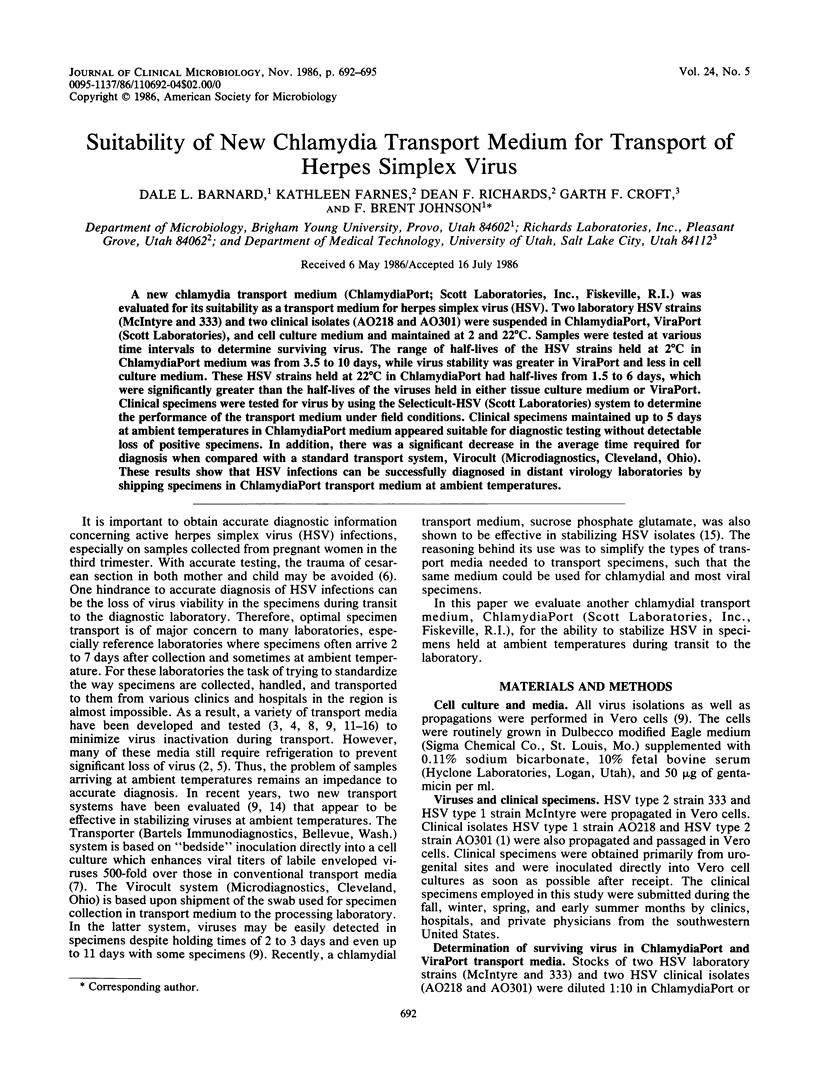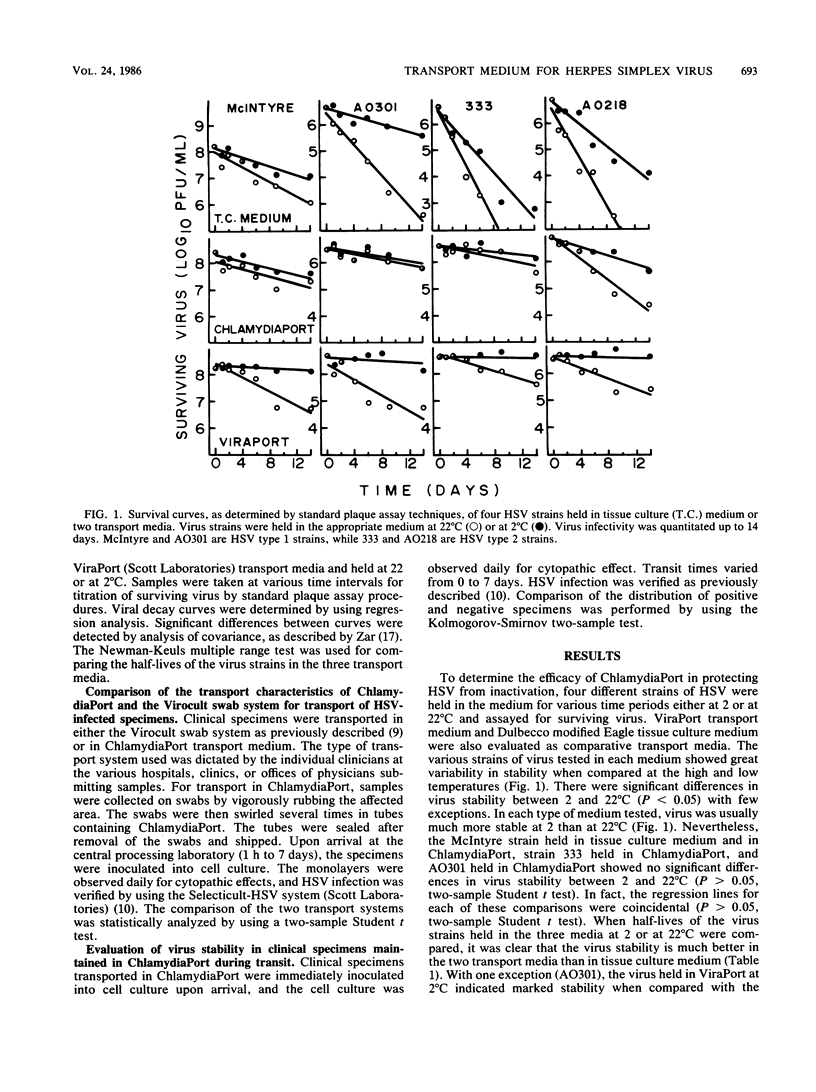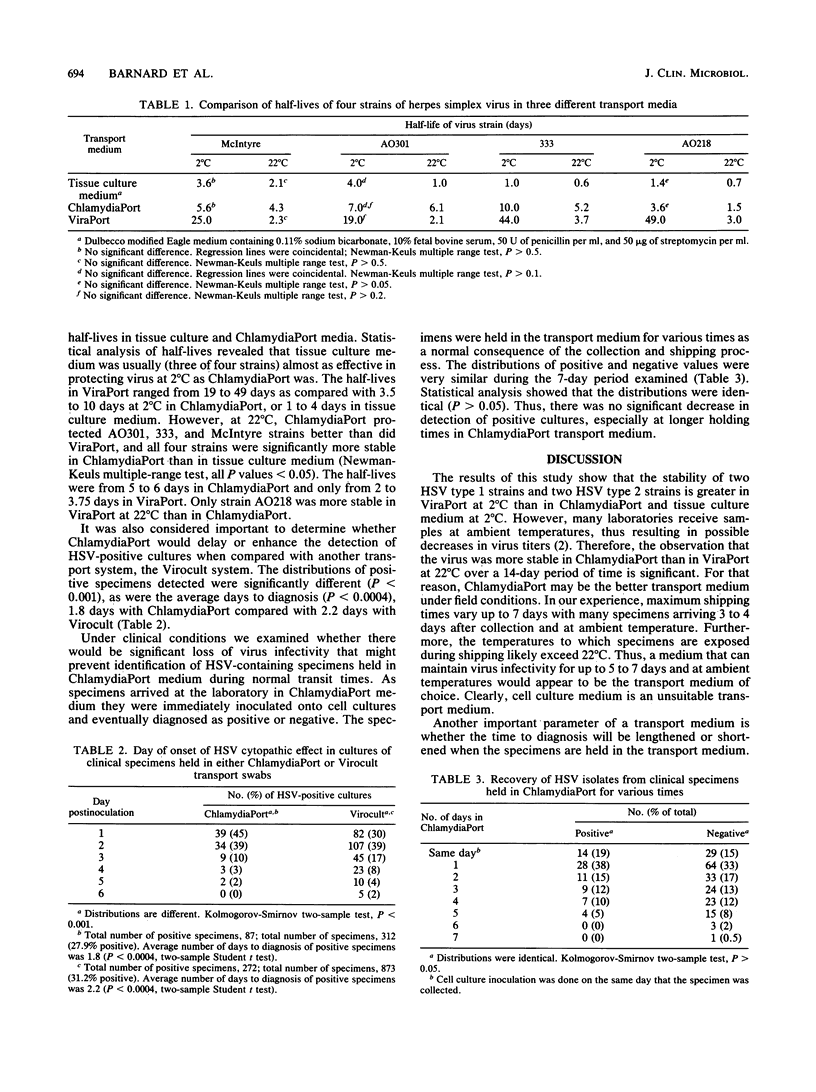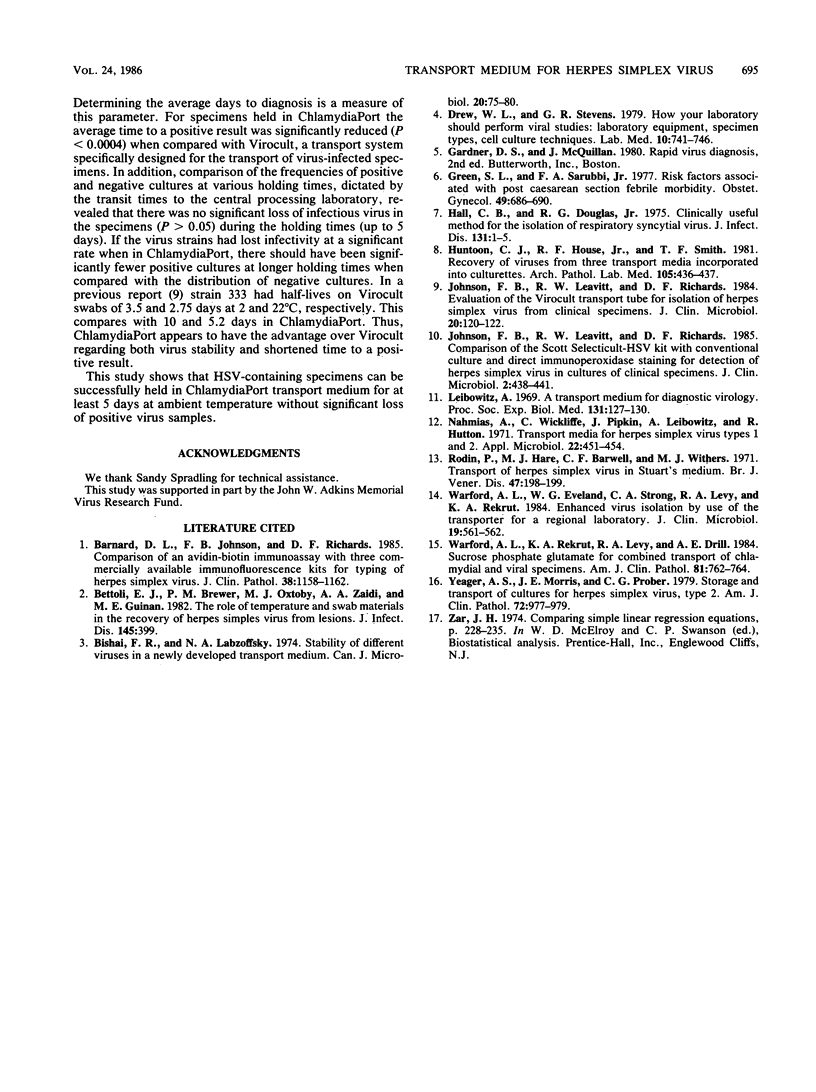Abstract
A new chlamydia transport medium (ChlamydiaPort; Scott Laboratories, Inc., Fiskeville, R.I.) was evaluated for its suitability as a transport medium for herpes simplex virus (HSV). Two laboratory HSV strains (McIntyre and 333) and two clinical isolates (AO218 and AO301) were suspended in ChlamydiaPort, ViraPort (Scott Laboratories), and cell culture medium and maintained at 2 and 22 degrees C. Samples were tested at various time intervals to determine surviving virus. The range of half-lives of the HSV strains held at 2 degrees C in ChlamydiaPort medium was from 3.5 to 10 days, while virus stability was greater in ViraPort and less in cell culture medium. These HSV strains held at 22 degrees C in ChlamydiaPort had half-lives from 1.5 to 6 days, which were significantly greater than the half-lives of the viruses held in either tissue culture medium or ViraPort. Clinical specimens were tested for virus by using the Selecticult-HSV (Scott Laboratories) system to determine the performance of the transport medium under field conditions. Clinical specimens maintained up to 5 days at ambient temperatures in ChlamydiaPort medium appeared suitable for diagnostic testing without detectable loss of positive specimens. In addition, there was a significant decrease in the average time required for diagnosis when compared with a standard transport system, Virocult (Microdiagnostics, Cleveland, Ohio). These results show that HSV infections can be successfully diagnosed in distant virology laboratories by shipping specimens in ChlamydiaPort transport medium at ambient temperatures.
Full text
PDF



Selected References
These references are in PubMed. This may not be the complete list of references from this article.
- Barnard D. L., Johnson F. B., Richards D. F. Comparison of an avidin-biotin immunoassay with three commercially available immunofluorescence kits for typing of herpes simplex virus. J Clin Pathol. 1985 Oct;38(10):1158–1162. doi: 10.1136/jcp.38.10.1158. [DOI] [PMC free article] [PubMed] [Google Scholar]
- Bettoli E. J., Brewer P. M., Oxtoby M. J., Zaidi A. A., Guinan M. E. The role of temperature and swab materials in the recovery of herpes simplex virus from lesions. J Infect Dis. 1982 Mar;145(3):399–399. doi: 10.1093/infdis/145.3.399. [DOI] [PubMed] [Google Scholar]
- Bishai F. R., Labzoffsky N. A. Stability of different viruses in a newly developed transport medium. Can J Microbiol. 1974 Jan;20(1):75–80. doi: 10.1139/m74-012. [DOI] [PubMed] [Google Scholar]
- Green S. L., Sarubbi F. A., Jr Risk factors associated with post cesarean section febrile morbidity. Obstet Gynecol. 1977 Jun;49(6):686–690. [PubMed] [Google Scholar]
- Hall C. B., Douglas R. G., Jr Clinically useful method for the isolation of respiratory syncytial virus. J Infect Dis. 1975 Jan;131(1):1–5. doi: 10.1093/infdis/131.1.1. [DOI] [PubMed] [Google Scholar]
- Huntoon C. J., House R. F., Jr, Smith T. F. Recovery of viruses from three transport media incorporated into culturettes. Arch Pathol Lab Med. 1981 Aug;105(8):436–437. [PubMed] [Google Scholar]
- Johnson F. B., Leavitt R. W., Richards D. F. Comparison of the Scott Selecticult-HSV kit with conventional culture and direct immunoperoxidase staining for detection of herpes simplex virus in cultures of clinical specimens. J Clin Microbiol. 1985 Mar;21(3):438–441. doi: 10.1128/jcm.21.3.438-441.1985. [DOI] [PMC free article] [PubMed] [Google Scholar]
- Johnson F. B., Leavitt R. W., Richards D. F. Evaluation of the virocult transport tube for isolation of herpes simplex virus from clinical specimens. J Clin Microbiol. 1984 Jul;20(1):120–122. doi: 10.1128/jcm.20.1.120-122.1984. [DOI] [PMC free article] [PubMed] [Google Scholar]
- Leibovitz A. A transport medium for diagnostic virology. Proc Soc Exp Biol Med. 1969 May;131(1):127–130. doi: 10.3181/00379727-131-33820. [DOI] [PubMed] [Google Scholar]
- Nahmias A., Wickliffe C., Pipkin J., Leibocitz A., Hutton R. Transport media for herpes simplex virus types 1 and 2. Appl Microbiol. 1971 Sep;22(3):451–454. doi: 10.1128/am.22.3.451-454.1971. [DOI] [PMC free article] [PubMed] [Google Scholar]
- Rodin P., Hare M. J., Barwell C. F., Withers M. J. Transport of herpes simplex virus in Stuart's medium. Br J Vener Dis. 1971 Jun;47(3):198–199. doi: 10.1136/sti.47.3.198. [DOI] [PMC free article] [PubMed] [Google Scholar]
- Warford A. L., Eveland W. G., Strong C. A., Levy R. A., Rekrut K. A. Enhanced virus isolation by use of the transporter for a regional laboratory. J Clin Microbiol. 1984 Apr;19(4):561–562. doi: 10.1128/jcm.19.4.561-562.1984. [DOI] [PMC free article] [PubMed] [Google Scholar]
- Warford A. L., Rekrut K. A., Levy R. A., Drill A. E. Sucrose phosphate glutamate for combined transport of chlamydial and viral specimens. Am J Clin Pathol. 1984 Jun;81(6):762–764. doi: 10.1093/ajcp/81.6.762. [DOI] [PubMed] [Google Scholar]
- Yeager A. S., Morris J. E., Prober C. G. Storage and transport of cultures for Herpes simplex virus, type 2. Am J Clin Pathol. 1979 Dec;72(6):977–979. doi: 10.1093/ajcp/72.6.977. [DOI] [PubMed] [Google Scholar]


